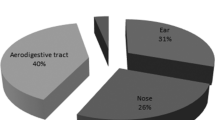Abstract
Background
Nasal foreign body(-ies) (FB) cause local irritation, inflammation, and mucosal erosion and carry a potential risk of aspiration. The aim is to describe the management of nasal FBs in our Emergency Department (ED).
Method
A retrospective study of 100 sequential suspected nasal FB presentations to a tertiary paediatric ED. Patient age, gender, FB typology, doctor/nurse seniority, sedation/analgesia usage, removal method, ENT referral rate, extraction time and disposition were collected. Data was inputted to Microsoft Excel®.
Results
One hundred cases were encountered over 16 months: 51 males and 49 females. Median age was 3.4 years (range 0.8–10). Of the 73 FB visualised in the ED, 78% (57/73) were successfully removed by ED staff. Sixteen visualised in ED required ENT removal. Of those 16 FBs, 7 were removed at OPD while 9 were removed by ENT in ED.
Discussion
The ED physician/advanced nurse practitioner successfully managed most children with a nasal FB in the ED. The goal of the management should be to minimise complications/repeated attempts. Formation of a national guideline to assist in ED removal and timely care will hopefully improve patient’s experience. It will include guidance on topical anaesthetic use, performing radiographs for radiopaque objects not initially visualised and limiting ED staff extraction attempts.


Similar content being viewed by others
References
Kiger JR, Brenkert TE, Losek JD (2008) Nasal foreign body removal in children. Pediatr Emerg Care 24:785–792. https://doi.org/10.1097/PEC.0b013e31818c2cb9
Nandapalan V, Mcilwain JC (1994) Removal of nasal foreign bodies with a Fogarty biliary balloon catheter. J Laryngol Otol 108(9):758–760. https://doi.org/10.1017/S0022215100128038
Baker MD (1987) Foreign bodies of the ears and nose in childhood. Pediatr Emerg Care 3(2):67Y70
Guidera AK, Stegehuis HR (2010) Button batteries: the worst case scenario in nasal foreign bodies. N Z Med J 123(1313):68–73
Awad AH, Eltaher M (2017) ENT foreign bodies: an experience. Int Arch Otorhinolaryngol 22:146–151. https://doi.org/10.1055/s-0037-1603922
Tong MC, Ying SY, van Hasselt CA (1996) Nasal foreign bodies in children. Int J Pediatr Otorhinolaryngol 35(3):207–211
Kadish HA, Corneli HM (1997) Removal of nasal foreign bodies in the pediatric population. Am J Emerg Med 15(1):54–56. https://doi.org/10.1016/S0735-6757(97)90049-8
Ui Bhrian S, Blackburn C (2018) Irish Association for Emergency Medicine. Foreign bodies: the emergency department management of inhaled and inserted objects in children. IAEM CG12
Scholes MA, Jensen EL (2016) Presentation and management of nasal foreign bodies at a tertiary children’s hospital in an American metro area. Int J Pediatr Otorhinolaryngol 88:190–193. https://doi.org/10.1016/j.ijporl.2016.07.016
Mackle T, Conlon B (2006r) Foreign bodies of the nose and ears in children. Should these be managed in the accident and emergency setting? Int J Pediatr Otorhinolaryngol 70(3):425–428
Gupta R, Nyakunu RP, Kippax JR (2016) Ear Nose Throat J 95(3):113–116
Glynn F, Amin M, Kinsella J (2008) Nasal foreign bodies in children: should they have a plain radiograph in the accident and emergency? Pediatr Emerg Care 24(4):217–218. https://doi.org/10.1097/PEC.0b013e31816a9f1b
Chan TC, Ufberg J, Harrigan RA, Vilke GM (2004) Nasal foreign body removal. J Emerg Med 26:441–445. https://doi.org/10.1016/j.jemermed.2003.12.024
Davies PH, Benger JR (2000) Foreign bodies in the nose and ear: a review of techniques for removal in the emergency department. Emerg Med J 17:91–94
Shrestha I, Shrestha BL, Amatya RCM (2012) Analysis of ear, nose and throat foreign bodies in Dhulikhel hospital. Kathmandu Univ Med J 10(38):4–8
Fox JR (1980) Fogarty catheter removal of nasal foreign bodies. Ann Emerg Med 9(1):37–38. https://doi.org/10.1016/S0196-0644(80)80439-2
Author information
Authors and Affiliations
Corresponding author
Additional information
Publisher’s note
Springer Nature remains neutral with regard to jurisdictional claims in published maps and institutional affiliations.
Rights and permissions
About this article
Cite this article
Dann, L., Doody, J., Howard, R. et al. Nasal foreign bodies in the paediatric emergency department. Ir J Med Sci 188, 1401–1405 (2019). https://doi.org/10.1007/s11845-019-02000-z
Received:
Accepted:
Published:
Issue Date:
DOI: https://doi.org/10.1007/s11845-019-02000-z




